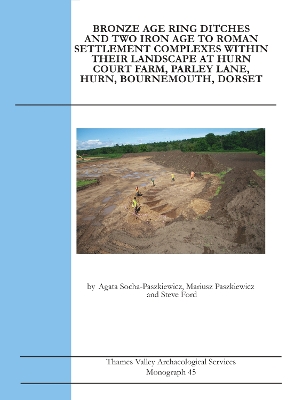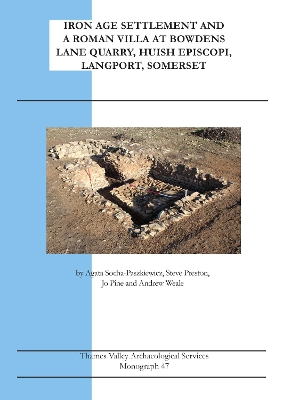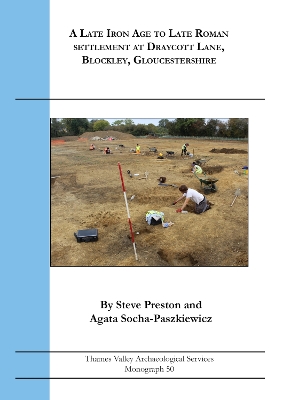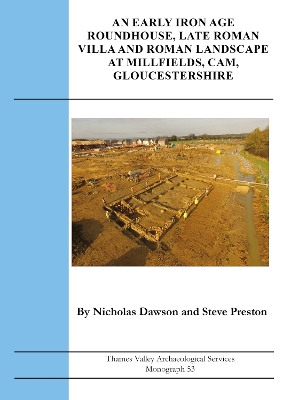TVAS Monograph
5 primary works
Book 45
Fieldwork in advance of mineral extraction revealed a range of settlement and burial deposits of Neolithic, Earlier Bronze Age, Middle Iron Age and Roman dates. A few Mesolithic flints were also found. The distinctive deposits of Bronze Age date were four ring ditches. One was fully excavated, two partially excavated and another preserved in-situ. It is uncertain if a fifth partially excavated feature was a ring ditch or a sub-circular Roman enclosure. Ephemeral traces of broadly contemporary occupation were also recorded. The main archaeological deposits were two dense settlement complexes, just 300m apart, demonstrating considerable time depth with numerous intercutting features, multi-recut linear features and reorganized boundaries. The South site commenced as a circular enclosure in the Early Iron Age (c. 5th century BC) and was the genesis of a settlement that seemed to be continuously occupied up until the early 4th century AD. The North site commenced as an area of Late Iron Age field boundaries before developing into a large settlement complex again seemingly occupied continuously without a break into mid-4th century Roman times. Although there are no physical links between the two complexes, the ?triangular? form and orientation of funnel arrangement of ditches opening on to a large undeveloped area, suggests use of common pastureland.
Book 47
Excavations in advance of mineral extraction revealed extensive archaeological remains spanning the early Bronze Age to the late Roman periods, with a few later features. The chief periods of activity were the later Bronze Age to early Iron Age, the middle Iron Age and early through to later Roman times. An extensive spread of deposits has been interpreted as a midden, rich in Later Bronze Age to early Iron Age pottery, which is a well-recognized 'feature' type for the period, albeit still rarely found, as preservation especially over such a wide area as here must be assumed to be rare. The prehistoric ceramics, mainly from this 'midden', form a regionally significant group. Iron Age roundhouses in two foci were accompanied by numerous pits and several 4-poster 'granaries', suggesting a protracted occupation in this period.
A further ring gully seems to have been the site of an early Roman roundhouse, and this was soon followed by a sequence of rectangular stone structures which by the 3rd century would merit the designation as a villa, albeit a very modest one. Two structures appear to be corn-drying ovens, although it is not ruled out that the more elaborate one was a small plunge bath. A notable aspect of the site is the presence of human burials, perhaps in all the main periods of use and certainly in the later Roman phase. Isotope analysis suggests that all three of the individuals sampled originated in a colder climate than south-west Britain. The site chronology is supported by a series of radiocarbon dates.
A further ring gully seems to have been the site of an early Roman roundhouse, and this was soon followed by a sequence of rectangular stone structures which by the 3rd century would merit the designation as a villa, albeit a very modest one. Two structures appear to be corn-drying ovens, although it is not ruled out that the more elaborate one was a small plunge bath. A notable aspect of the site is the presence of human burials, perhaps in all the main periods of use and certainly in the later Roman phase. Isotope analysis suggests that all three of the individuals sampled originated in a colder climate than south-west Britain. The site chronology is supported by a series of radiocarbon dates.
Book 48
A Beaker Pit, an Iron Age and Late Roman Occupation at Laurels Road, Offenham, Worcestershire
by Jo Pine and Steve Preston
Published 31 July 2024
Archaeological excavation of a 0.64ha area in advance of development of a larger field produced evidence of use of this landscape from the late Neolithic/early Bronze Age (Beaker period), middle to late Iron Age and middle to late Roman, besides later ridge and furrow. The Beaker period was represented only by a single pit containing the period’s distinctive pottery, with no evidence of the burial that often accompanies such deposits.
A large C-shaped ditch can be dated to the Middle Iron Age, although it also received later pottery. It cut across a couple of field boundary ditches which also underlay a square enclosure surrounding a grave of Late Iron Age date. The burial, of a man aged in his 40s or older, had been placed beneath stone slabs but with no grave goods (except some probably incidental pottery sherds). A radiocarbon date places the burial (most probably) in the late 1st century BC or early 1st century AD.
The main results of the excavation, however, date to the Roman period, from the middle of the 2nd century until the late 4th or even early 5th century. it had been anticipated that the site might contain a villa but no such structure was located, the features being mainly ditches, representing field boundaries or enclosures. Nonetheless some f the finds assemblages do suggest a relatively affluent site and it remains possible that there is a villa nearby, and the presence of a presumed corn-dryer tends to support this suggestion. A suggestion of continuity into the 5th century is difficult to substantiate on any grounds other than the stratigraphic depth of the ‘latest Roman’ period which has to accommodate at least three sub-phases involving fairly substantial changes in layout and seems difficult to reconcile with a shorter chronology entirely confined to the late 4th century. The latest feature, a very large ditch, puts the earlier field systems completely out of use.
A large C-shaped ditch can be dated to the Middle Iron Age, although it also received later pottery. It cut across a couple of field boundary ditches which also underlay a square enclosure surrounding a grave of Late Iron Age date. The burial, of a man aged in his 40s or older, had been placed beneath stone slabs but with no grave goods (except some probably incidental pottery sherds). A radiocarbon date places the burial (most probably) in the late 1st century BC or early 1st century AD.
The main results of the excavation, however, date to the Roman period, from the middle of the 2nd century until the late 4th or even early 5th century. it had been anticipated that the site might contain a villa but no such structure was located, the features being mainly ditches, representing field boundaries or enclosures. Nonetheless some f the finds assemblages do suggest a relatively affluent site and it remains possible that there is a villa nearby, and the presence of a presumed corn-dryer tends to support this suggestion. A suggestion of continuity into the 5th century is difficult to substantiate on any grounds other than the stratigraphic depth of the ‘latest Roman’ period which has to accommodate at least three sub-phases involving fairly substantial changes in layout and seems difficult to reconcile with a shorter chronology entirely confined to the late 4th century. The latest feature, a very large ditch, puts the earlier field systems completely out of use.
Book 50
A Late Iron Age to Late Roman Settlement at Draycott Lane, Blockley, Gloucestershire
by Steve Preston and Agata Socha-Paszkiewicz
Published 30 June 2024
Archaeological excavation revealed a latest Iron Age to Roman settlement typical of the Cotswold Hills for this period. The fieldwork revealed a complex settlement comprising numerous ditched (and hedged) pens, paddocks and enclosures which had been re-ordered on numerous occasions. The settlement was not enclosed per se but was aligned on a nearby ditched trackway. The emphasis on numerous small enclosures is thought to indicate that livestock management was the dominant economic activity of the occupants. Sieving recovered few charred cereal seeds and no facilities for cereal processing (such as corn driers) or storage were recorded. The faunal remains indicated a typical range of stock animals dominated by cattle followed by sheep and pig with some horse. Few finds were indicative of any wealth and the settlement was probably that of an ordinary farming community comprised of several related families.
As with many settlement across southern England the site originated in the mid 1st century AD, flourished in the 2nd and 3rd centuries AD only to decline and then be abandoned in the 4th century AD. There were no indications of later occupation until the site was overlain by Medieval ditches and ridge and furrow field system.
As with many settlement across southern England the site originated in the mid 1st century AD, flourished in the 2nd and 3rd centuries AD only to decline and then be abandoned in the 4th century AD. There were no indications of later occupation until the site was overlain by Medieval ditches and ridge and furrow field system.
Book 53
Fieldwork revealed details of a wide landscape of Roman fields and enclosures laid out around the junction of two droveways and probably spanning the entire Roman period. An early Iron Age roundhouse radiocarbon dated to 653-542 cal BC had previously occupied the same area that was to be close to the heart of the Roman enclosures. However, the chief interest of the site lies in the late Roman period (later 3rd to 4th century) when a rectangular villa was constructed on the terrace edge overlooking the river Cam. Initially of just three rooms it was soon expanded to six and the southern end was then subdivided to form a bath suite. Although of very simple plan form, the building was of some sophistication with very substantial deep stone foundations carrying stone walls, an elaborate hypocaust, decoratively painted wall plaster, stone roof, and furniture including some with decorative stone tops. Other signs of obvious wealth, however, are lacking. The villa seems to have been demolished by the end of the 4th century, possibly earlier.
The faunal component of the economy comprised a typical dominance of cattle followed by sheep/goat and pig with few exotic species, and the proportions of which changed little through the life of the settlement. Evidence for arable production was again typically modest, with no structures such as corn driers present, though millstones imply large scale production of flour.
The faunal component of the economy comprised a typical dominance of cattle followed by sheep/goat and pig with few exotic species, and the proportions of which changed little through the life of the settlement. Evidence for arable production was again typically modest, with no structures such as corn driers present, though millstones imply large scale production of flour.




